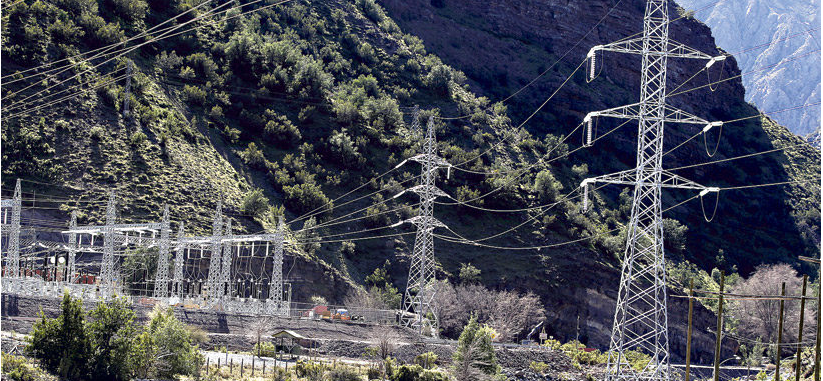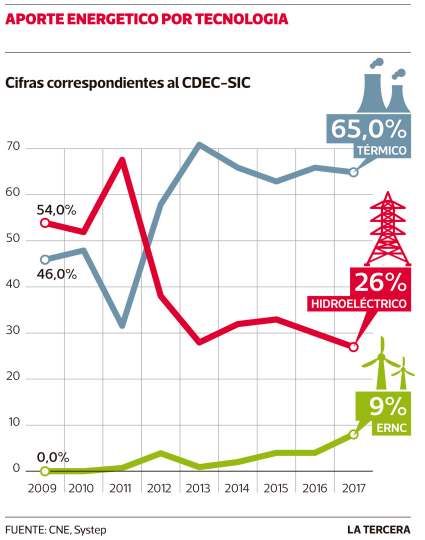
In March, according to CEN figures, reservoir or run-of-river production reached an all-time low. Higher gas injection, a boom in renewables and lower rainfall explain this situation.
Hydroelectric generation in the central zone falls to lowest level since records began: 26%.
The production of energy from water, the country’s largest own resource for generating electricity, is now at its lowest levels on record.
According to figures from the National Electric Coordinator (CEN), the entity that succeeded the former system coordinators, the SIC and Sing CDECs, hydroelectric production in the central zone accounted for 26% of the total in the third month of the year, considering both reservoir and run-of-river plants. This is 10 points less than in the previous month. This is the lowest figure on record, considering the material published by both the current CEN and the former CDECs.
This situation is related to several factors, the main one being the lack of rainfall in the country. According to data from the consulting firm Systep, the energy stored in the SIC is currently at “historically low levels, representing only 19% of the historical monthly average”.
In its latest monthly report it adds that “so far in the 2016/2017 hydrological year (April 2016 to March 2017), the observed surplus level is equal to 93%, that is, it ranks among the 7% of the driest hydrologies observed at the same date.”
This is in addition to the explosive increase in wind and solar production, which in March accounted for 9% of electricity production in the SIC, while in the Norte Grande it rose to 11% of the total. The positioning of natural gas as a cheap and reliable alternative for the system also has an impact, thanks to the Quintero and Mejillones terminals, which allow access to long-term contracts at advantageous prices to feed the country’s thermal fleet. Precisely for this reason, marginal energy costs have not soared, remaining below US$ 100 per MWh (US$ 84.7 per MWh on average in March).
According to Rodrigo Solís, Manager of Studies and Contents of the Chilean Association of Generators, the lower hydroelectric production is also related to seasonality, as March is the last month of the thawing period that begins in September in the central-southern zone, of which the SIC is a part. In other words, if it rained little during the winter, the month in which it will be most noticeable will be March-April, when the reservoirs are at their minimum levels.
“This implies that generally in that month hydroelectric power plants are generating the last of the remaining snow melt. During the 2016 winter, not much snow accumulated so in March 2017 it was to be expected that hydropower contributions would be lower than in previous years. What happens in the coming months will depend on the hydrological behavior of the hydrological year that starts in April 2017 and lasts until March 2018”, complements the expert.
The executive also explains that in order for the system to supply the total demand for electricity, the generation contributions are complemented among the different technologies in increasing order of operating cost, starting with run-of-river hydroelectric, solar and wind power renewables, and then thermoelectric in order of lowest to highest operating cost.
Despite this, the industry believes that hydroelectricity will continue to play a key role in the country’s energy future and this is recognized in both the Energy Agenda of former Minister Máximo Pacheco and the Energy 2050 document, presented in 2015, which lays the foundations for the country’s electricity development.
“The energy policy recognizes a place for hydroelectricity in all future development scenarios not only for its contribution in energy, its renewable nature that displaces emissions from other sources, and its contribution in giving flexibility to the system that facilitates the penetration of variable renewable energies such as solar photovoltaic and wind. That is why the work of the sustainable hydroelectricity roundtable has just been completed with the aim of establishing criteria for the future development of this technology, and thus achieve progress in the goal of renewables”, he adds.
Energy agenda
The Minister of Energy, Andrés Rebolledo, adds further elements: “As is well known, for several years the central and southern part of the country has been affected by a prolonged drought.
This has impacted several activities, including hydroelectric power generation,” he says, adding that “in fact, this year is among the worst in the last 30 years in terms of hydrology.
In his vision, the increase in the participation of NCRE in the matrix is not necessarily displacing water, because given that most of them are produced in the north of the country, and the limitations in transmission, today not all that energy reaches the consumption centers in the regions that are served by hydroelectricity.
“The contribution of NCRE has made it possible, among other things, to displace other generation such as diesel plants, helping to reduce CO2 emissions into the atmosphere,” says Rebolledo, who argues that today NCRE represents about 15% of the system’s installed capacity. “The goal that we have set for ourselves, and that we will probably meet before the stipulated date, 2025, is to reach 20%.”
He added that “the Energy Agenda contemplates promoting the development of the country’s own renewable energy resources. The greater participation of NCRE has allowed diversifying the matrix and incorporating renewable and economically efficient energies”, concluded the authority.






